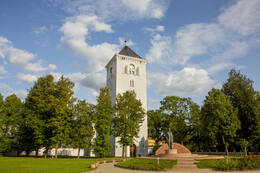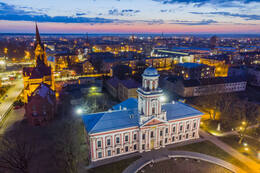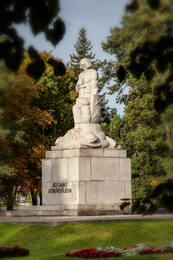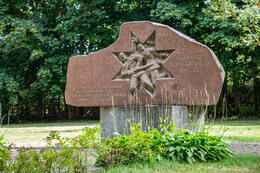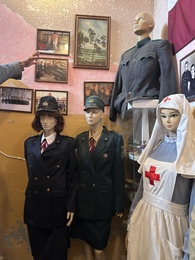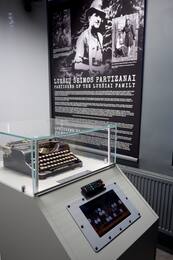Didysis pasienio karinio paveldo maršrutas Latvijoje ir Lietuvoje: 100 metų nepriklausomybės
Diena 1.
90 km
Jelgava - Elėja - Joniški - Šiauliai
Praktinė informacija
- Maršrutas skirtas kaip vadovas – kaip optimaliai keliauti po regioną ar šalį, arba dvi šalis, siekiant pažinti jų karinį paveldą;
- Vairuotojas turi pats suplanuoti – kiek iš rekomenduojamų objektų ir vietų jis gali apžiūrėti per vieną dieną;
- Prieš kelionę reikėtų pasitikrinti lankytinų vietų (muziejų, kolekcijų, įtvirtinimų ir kt.) darbo laiką;
- Vietose, kur būtina išankstinė rezervacija (vietiniai gidai, privačios kolekcijos ir kt.), apsilankymą būtina užsisakyti, nurodant datą ir laiką. Jei kelionė atšaukiama, apie tai reikia informuoti užsakytų vietų atstovus;
- Apgyvendinimą būtina užsisakyti iš anksto. Vasaros sezonu apgyvendinimo paslaugos gali būti neprieinamos, ypač pajūryje. Kai kurios maitinimo įstaigos žiemos sezonu gali nedirbti;
- Kelionei rinkitės ne tik vasarą, bet ir kitus metų laikus;
- Latvijos, Lietuvos ir Estijos sienas keliais galima laisvai kirsti be apribojimų ir bet kuriuo paros metu. Vykstant iš vienos šalies į kitą, būtina su savimi turėti asmens tapatybės kortelę arba pasą;
- Apsilankykite turizmo informacijos centruose, kur galite gauti papildomos informacijos, brošiūrų ir žemėlapių.
Lankytinos vietos
Jelgavos Švč. Trejybės bažnyčios bokštas
Jelgavos Švč. Trejybės bažnyčios bokštas yra Jelgavos miesto centre.
Bokštas stovi daugiau nei keturis šimtmečius ir yra tapęs ne tik miesto raidos, bet ir skaudžių įvykių liudininku. Bažnyčios statyba pradėta 1574 m., vykdant Kuržemės ir Žiemgalos hercogo Gothardo Ketlerio potvarkį. Jos bokštas buvo užbaigtas 1688 m., vadovaujant meistrui Martinui Knochui, ir tapo vienu labiausiai matomu miesto statinių. Antrojo pasaulinio karo metais Jelgava buvo smarkiai nuniokota, o bažnyčia sudegė 1944 m., po SSRS aviacijos antskrydžio. Po karo sovietų valdžia susprogdino altoriaus dalį, o sienos buvo nugriautos. Išliko tik bokštas kaip strateginės reikšmės objektas, kadangi jis buvo aukščiausias mieste. Per karą ir pokariu bokštas buvo naudojamas karinėms reikmėms – iš jo buvo stebimos priešo pozicijos ir kontroliuojama aplinkinė teritorija.
Pokario metais bokštas atliko strateginę funkciją, vykdant pasipriešinimo veiklą. Jis tapo slapta susitikimų vieta ir informacijos, svarbios kovai su sovietiniu režimu, perdavimo vieta. Šiandien bokštas, išlaikęs savo istorinę reikšmę, atgimė kaip kultūros ir švietimo centras.
G. Eliaso Jelgavos istorijos ir meno muziejus
G. Eliaso Jelgavos istorijos ir meno muziejus įsikūręs pastate, vadinamame Academia Petrina (Petro akademija). Jis buvo pastatytas 1775 m. kaip pirmasis universitetas Latvijoje ir yra vienas iš nedaugelio Jelgavoje Jelgavoje išlikusių ir po Antrojo pasaulinio karo restauruotų visuomeninių pastatų. 1944-ųjų vasarą Jelgava prarado beveik viską – didelę dalį gyventojų ir istorinių pastatų, kurių dauguma po Antrojo pa saulinio karo taip ir nebuvo atstatyti. Dabartinio muziejaus pirmtakas – Kuržemės provincijos muziejus, įkurtas 1818 m. Tai buvo antras pagal senumą muziejus Latvijoje ir pirmasis už Rygos ribų. Nuo 1952 m. pastate veikia Academia Petri na muziejus. Šiandien muziejuje veikia nuolatinės parodos apie iškilų Latvijos menininką Ģedertą Eliasą (1887–1975), priešistorę ir viduramžius Žiemgaloje bei Jelgavos miestą įvairiais laikotarpiais – Kuržemės ir Žiemgalos kunigaikštystės (1561–1795 m.), Kuržemės gubernijos (1795–1918 m.) ir nepriklausomos Latvijos valstybės (1918–1940 m.) Muziejaus ekspozicija „Gyvenimas tęsiasi valdant sveti miems“ pasakoja apie gyvenimą Latvijoje vokiečių ir so vietų okupacijų metais.
Virtualioje muziejaus parodoje „Karai ir kareivis Jelgavos amžiais“ galima susipažinti su įvairiais Jelgavą palietusiais karais, įskaitant ir Pirmojo bei Antrojo pasaulinių karų isto rinius įvykius.
Paminklas Jelgavos išvaduotojams „Lačplėsis“ (Lāčplēsis)
Paminklas Jelgavos išvaduotojams „Lačplėsis“ stovi Jelgavoje, Stoties parke, priešais geležinkelio stoties pastatą. Jis buvo atidengtas 1932 m. birželio 22 d., dalyvaujant tuometiniam Latvijos prezidentui A. Kviesiui. Paminklas skirtas 1919 m. lapkričio 21 d. įvykusiam Jelgavos išvadavimui, Latvijos nepriklausomybės karų metu, atminti.
Per pirmąją sovietų okupaciją 1940 m. paminklas išliko nepaliestas. Tačiau 1941 m., kai sovietus pakeitė vokiečių okupacinė valdžia, paminklo dviprasmiška simbolika nepatiko į Jelgavą sugrįžusiam vokiečių okupacinės administracijos vadovui fon Medemui – jo protėviai buvo pirmieji Jelgavos pilies statytojai. 1942 m. spalio 31 d. vokiečių okupacinė val džia įsakė paminklo autoriui Karliui Jansonui pašalinti vokiečių riterio atvaizdą.
1950 m. sovietų okupacinė valdžia įsakė paminklą sunaikinti. Lačplėsio skulptūra buvo nuversta nuo postamento su traktoriumi, sudaužyta, o jos likučius mėginta sutrupinti akmenų trupintuvu. Tačiau Lačplėsis pasirodė esąs toks kietas, kad trupintuvas sugedo. Nesunaikinta paminklo vidurinė dalis buvo slapta užkasta vaikų darželio teritorijoje. 1988 m. ši paminklo dalis buvo surasta ir perkelta priešais G. Eliaso Jelgavos istorijos ir meno muziejų. Restauruotas paminklas buvo iškilmingai atidengtas 1992 m. lapkričio 21 d. Jį atkūrė skulptorius Andrejus Jansonsas – paminklo autoriaus Karlo Jansono sūnus.
Paminklas Jelgavos gynėjams
Paminklas Jelgavos gynėjams stovi Jelgavos apylinkėse, prie Svėtės mokyklos. Jis skirtas Daugavgryvos krašto apsaugos kariams, kurie 1915 m. balandžio pabaigoje sustabdė vokiečių kariuomenės veržimąsi į Jelgavą. 1915 m. gegužės pradžioje Jelgavoje buvo surengta iškilminga demonstracija, skirta šiam svarbiam įvykiui paminėti. Tai, kad latvių krašto apsaugos kariams pavyko sulaikyti vokiečių puolimą, tapo svarbiu argumentu – Janis Čakstė ir jo bendraminčiai tuo pasinaudojo siekdami įgyvendinti idėją kurti latvių šaulių dalinius Pirmojo pasaulinio karo metais.
Paminklas buvo atidengtas 1991 metais, o jo autorė – skulptorė Alvīne Veinbaha (1923–2011).
Elėjos karo muziejus
Muziejus įsikūręs Elėjoje, buvusios geležinkelio stoties pastate.
Elėjos karo muziejų įkūrė draugija „Žiemgalos šaulys“, kurios nariai aktyviai prisideda šviesdami visuomenę, rengdami ekspozicijas, parodas ir edukacines veiklas.
Pagrindinė muziejaus ekspozicija daugiausia skirta Antrajam pasauliniam karui. Joje eksponuojamos uniformos, ekipuotė, ginkluotė ir to laikotarpio fotografijos. Muziejuje galima nusifotografuoti vilkint įvairių istorinių laikotarpių ir kariuomenių uniformas. Nedideliame dviejų aukštų pastate saugoma keli šimtai karinio paveldo eksponatų. Be to, yra eksponatų, susijusių su Elėjos miestu ir apylinkėmis, jo istorija ir įžymiomis asmenybėmis.
Joniškio istorijos ir kultūros muziejus
Joniškio istorijos ir kultūros muziejus yra įsikūręs Joniškio miesto centre. Muziejus veikia nuo 1989 metų, jame pristatomos ekspozicijos, reprezentuojančios krašto istorijos ir archeologijos vertybes, etninės kultūros ir sakralinio meno paveldą.
Istoriko ir muziejininko, partizaninio judėjimo tyrinėtojo Dariaus Vičo iniciatyva muziejuje buvo įrengta Joniškio krašto partizanams skirta ekspozicija. Atskiroje patalpoje pristatomos už Lietuvos laisvę kovojusių partizanų asmenybės bei jų kova su sovietų okupacine valdžia.
Ekspozicijoje pristatoma autentiška spausdinimo mašinėlė “Olympia“, tarnavusi paskutiniems Joniškio krašto partizanams Kostui Liuberskiui-Žvainiui ir Steponui Erstikiui-Patašonui: ja buvo spausdinami partizanų periodinio leidinio „Partizanų šūvių aidas“ numeriai. “Partizanų šūvių aidas” - pogrindinis laikraštis, leistas 1952–1957 m. Juozapavičiaus tėvūnijos teritorijoje (Akmenės, Joniškio, Žagarės ir Kuršėnų rajonų paribiuose). Tai – vėliausiai ėjęs partizanų periodinis leidinys.
Spausdinimo mašinėlė pritaikyta interaktyviam pažinimui – spaudžiant jos klavišus, lankytojas pamato nuotraukas ir išgirsta partizaninio pasipriešinimo istorijas. Eksponuojamas radijo imtuvas taip pat leidžia pasiklausyti partizanų kūrybos dainų.
Vietos pavalgyti
- Jelgavoje žr. visit.jelgava.lv
- Joniškio ežeras. visitjoniskis.lt
- Kavinė "Svētes Club", Svētes parapija
- Mados restoranas, Joniškis
- Seklumos, žr. visiteaulai.lt
Vietos apsistoti
- Jelgavoje žr. visit.jelgava.lv
- Joniškio ežeras. visitjoniskis.lt
- Viešbutis “Senliči”, Jaunvirslauko parapija, https://www.celotays.com
- Viešbutis „Shiaurės Vartai“, Joniškis
- Seklumos, žr. visiteaulai.lt




